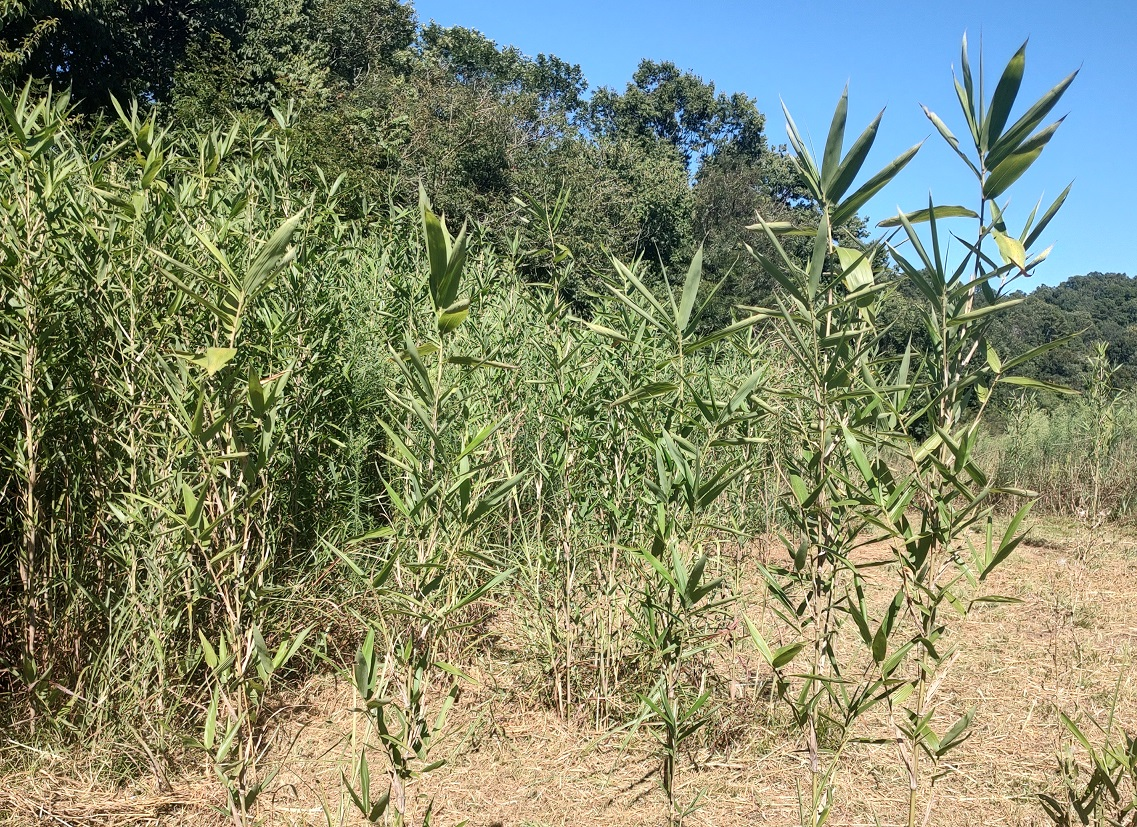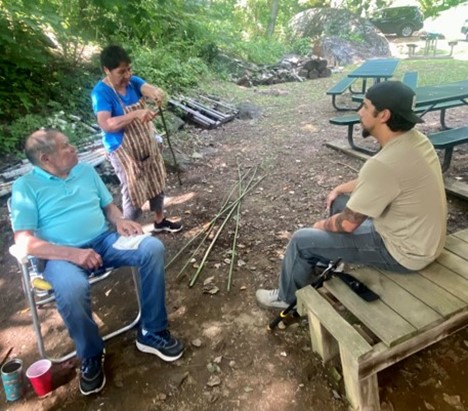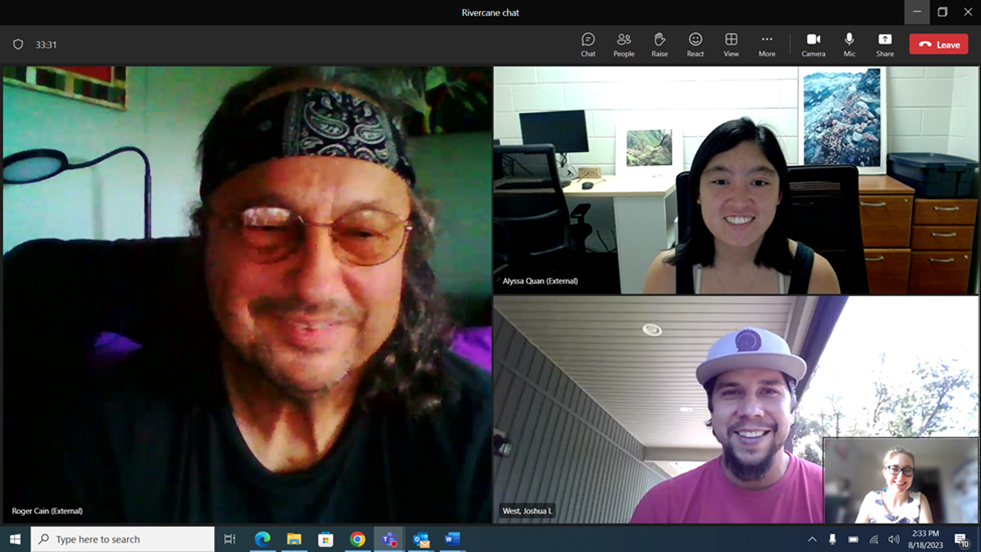Integrating rivercane as Indigenous Traditional Ecological Knowledge into the Southeast Conservation Blueprint

Have you heard about the great work being done in rivercane conservation partnerships across the Southeast United States? This summer, SECAS joined in this work by welcoming a group of three fellows to develop a new indicator for this culturally and ecologically significant species: Levi West, Alyssa Quan, and Jennifer Byram with the U.S. Fish and Wildlife Service Directorate Fellowship Program and the Public Lands Corps.
Rivercane (Arundinaria gigantea) is a bamboo plant native to the Southeastern United States that has played a major role in sustaining cultural practices and ecological systems for many Indigenous communities since time immemorial. Though canebrakes were once prolific throughout the Southeast, today this species and the ecosystems it created have been reduced to approximately 2% of their pre-colonization land area. Not only are rivercane ecosystems threatened, but so are key Southeast Indigenous cultural traditions linked to rivercane. These practices have become increasingly challenging to pass on in the face of severely limited access to rivercane sources and dwindling numbers of aging basket makers who rely on rivercane for their art. As steps like the listing of rivercane on Cherokee Nation’s Culturally Protected Species list demonstrate, the need for conservation action and education regarding the status of rivercane on the landscape has never been more critical.

Throughout this fellowship project, we have been working to promote rivercane conservation by working alongside partners to establish a collaborative model, build educational materials, and document a plan for spatial modeling to build a strong foundation for future SECAS work in rivercane. Our partners included Michael Fedoroff with the Rivercane Restoration Alliance (a partnership between tribal nations and federal agencies), Roger Cain of the United Keetoowah Band of Cherokee Indians, Ryan Spring from the Choctaw Nation of Oklahoma, and Dr. Caleb Hickman from the Eastern Band of Cherokee Indians.
These partners took the lead in guiding the team toward tribal data sovereignty solutions and prioritizing tribal management of rivercane towards healthier rivercane ecosystems. With their assistance and guidance from SECAS staff, we are developing preliminary documentation for two new rivercane indicators and drafting an agreement for formalizing these partnerships into the future. The goal of these indicators will be to help prioritize areas for conservation action to both protect existing rivercane and restore potential rivercane ecosystems. Because rivercane is a cultural and ecological keystone species, these indicators emphasize the integration of cultural and ecological values across the landscape in order to better prioritize lands with the highest potential for sustainable rivercane use and management. The indicators will combine environmental drivers such as fire frequency, land cover, proximity to tribal lands, and others with the goal of helping rivercane managers across the Southeast determine the best conservation approaches. These plans are works in progress and will be revised with our tribal partners through an iterative process.
Collaborating with tribal nations and working with Indigenous knowledge and data requires equitable communication strategies from the start of project initiation. Building interpersonal relationships while recognizing the sensitivity of cultural information and promoting data sovereignty is key to making progress in co-management between tribal and federal partners. We are thankful to our partners for dedicating their time and expertise toward this project as well as the incredible support of SECAS staff who made this project possible!

Levi, Alyssa, and Jennifer will be presenting more on their fellowship work at the next Third Thursday Web Forum on September 21st, so stay tuned for more info on the rivercane project! You can also check out the recording of the February Third Thursday Web Forum, which featured Roger Cain, to learn more about rivercane’s ecological and cultural significance and ongoing tribally led restoration efforts.
Webinar connection information:
- Date: September 21st
- Time: 10 am - 11 am ET
- Learn more on the SECAS event calendar: https://calendar.google.com/calendar/event?eid=NWplcHU3aDRkNGFxMzJoYTBrNmNnZTNqM2kgc2VjYXNzb3V0aGVhc3RAbQ&ctz=America/New_York
- Join the Teams meeting (no advance registration required): https://teams.microsoft.com/l/meetup-join/19%3ameeting_MjliZmYyN2EtOWY1Yi00N2FjLTkyOTYtZWRiNTJkNjAyNGIy%40thread.v2/0?context=%7b%22Tid%22%3a%220693b5ba-4b18-4d7b-9341-f32f400a5494%22%2c%22Oid%22%3a%22765228b1-d0d0-4438-812e-51cbb57819f1%22%7d
About the fellows:
- Joshua ‘Levi’ West is a Masters of Science student in Sustainability Leadership at Arizona State University and works for his tribe, the Eastern Band of Cherokee Indians, leading two youth leadership programs on top of being an artist working in pottery and learning rivercane basketry.
- Alyssa Quan is a PhD student in Integrative Conservation at the University of Georgia Odum School of Ecology and has been working with the Eastern Band of Cherokee Indians for her dissertation research on cultural and ecological management of rivercane.
- Jennifer Byram is a PhD student in Archaeology at the University of Arizona in the School of Anthropology and works for her tribe in the Choctaw Nation of Oklahoma Historic Preservation department.